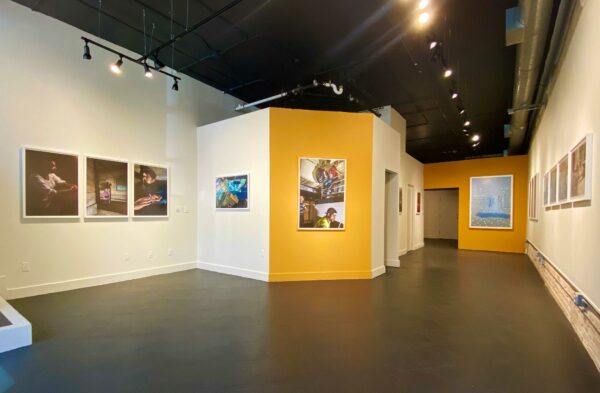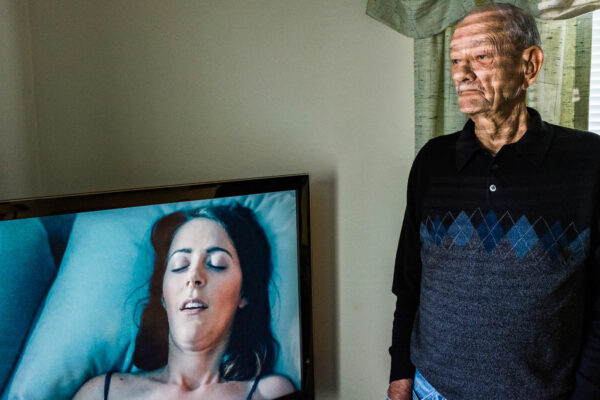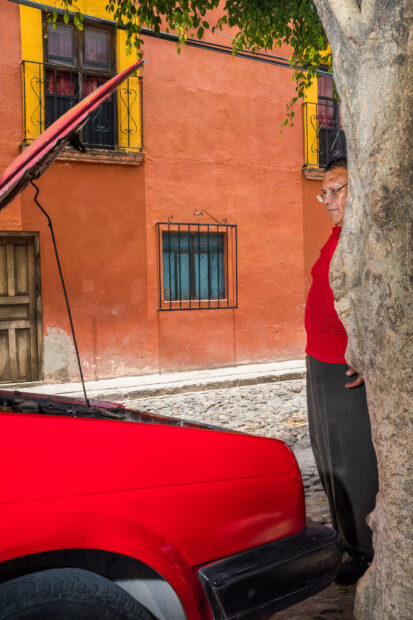
Installation view of “Field Patterns and Test Recordings” by Bill McCullough at Northern-Southern. Photo: Phillip Niemeyer
Bill McCullough’s latest solo show, Field Patterns and Test Recordings, at Northern-Southern gallery presents an arresting collection of street photographs.
A self-taught photographer and a musician, McCullough possesses a talent for improvisation that’s informed by both of his artistic practices. Playing pedal steel guitar for the cherished Austin-based band Knife in the Water, he’s no stranger to witnessing a work of art take shape through experimentation. To him, taking photos follows the same logic as making music. Both have a basic, loose structure that allows for exploration and the uncovering of unpredictable harmonies.
McCullough is best known for his work shooting weddings with this distinctly unrehearsed approach. While wedding photography tends to imply a focus on the client’s sentimental desires more than a photographer’s vision, McCullough ventures to represent the event as we experience it. Focusing on the unposed, his work never shies away from showing the tension and boredom that’s just as prevalent in weddings as love and joy. Flouting against the pretensions of airbrush, high curation, and feigned sincerity that tend to produce a mawkish outcome, McCullough’s defining talent is his ability to capture the drama of various encounters without significant alteration or fabrication.
McCullough employs the same daring style for the pictures in Field Patterns and Test Recordings. Taken between 2008 and 2020, the prints depict unscripted moments in various familiar and unassuming public settings, including dance halls, subways, bars, homes, and the street. His spontaneity births access to authenticity, and in his subjects we see real tension, humor, fatigue, melancholy, or all of the above, in seemingly normal moments. This is McCullough’s distinct skill: the ability to draw out a compelling narrative that turns passing strangers into protagonists and casts the mundane in a captivating light.
McCullough utilizes a tried-and-true method for obtaining genuine expressions that involves tiring his subjects out. At each shooting location, he walks around with clear signifiers of his profession: his camera with a fixed 35mm or 50mm lens and occasionally a handheld flash device. Subjects grant him permission through nods and smiles, giving him the green light to continuously snap pictures. Eventually, they either forget about him or become worn down by his consistency, and drop any affectation.
A key characteristic of his photographs is their crispness. The images are highly saturated and shot with a large depth of field, keeping every detail in sharp focus and lucidly colored. There’s little tampering from the original shot as McCullough’s digital post-production is limited to basic adjustments like color temperature and contrast. The result is a starkness that feels fascinating and rare, particularly in our modern world of intense curation and artificiality. The aesthetic honesty is harsh, revealing subjects’ wrinkles, bruises, scars, sweat, and emotional expressions that don’t necessarily match their environment.
McCullough’s style amplifies oddity within the ordinary. Many of the moments he chooses to share are moments we may not bother to remember in our lives. Blue Window depicts a man on the street looking under the hood of his car, nearly hidden behind a protruding tree trunk. Enhanced with bright reds, burnt orange, blues, and yellows, there’s not much happening, yet every detail is portrayed so vividly that nothing goes unnoticed, and every aspect feels vital and peculiar. Break Dance is a layered and comedically dramatic print that captures a gang of senior citizens sitting down in a square dance hall. The focal figure is an older gentleman wearing a back brace, slumped over with boredom, exhaustion, or perhaps even pain. The rest of the company is seemingly less miserable yet still lacking enthusiasm. We can’t know exactly what these folks are thinking, but their expressions still seem to divulge something precious.
The layout of the prints, arranged by McCullough himself, discursively proposes connections between these fleeting moments. The configuration of, for example, two photos showing injured subjects in completely different contexts, points out patterns in everyday life and human behavior. Without an obvious storyline, we are encouraged to notice various synchronicities and come to our own conclusions about each scene, if we even have any.
Field Patterns and Test Recordings uncovers various curious events, offering an experience akin to catching a glimpse of a stranger’s lifestyle through their windows, and leaving you with the stimulating task of wondering what more could be going on. It’s evident through the ambiguous nature of the prints that McCullough doesn’t seek to push a specific narrative or message. Instead, he’s just an observer fascinated by the mysteries of the world, and he’s framed them for the rest of us to notice and reflect on.
Field Patterns and Test Recordings is on view at Northern-Southern in Austin through April 28, 2024.






